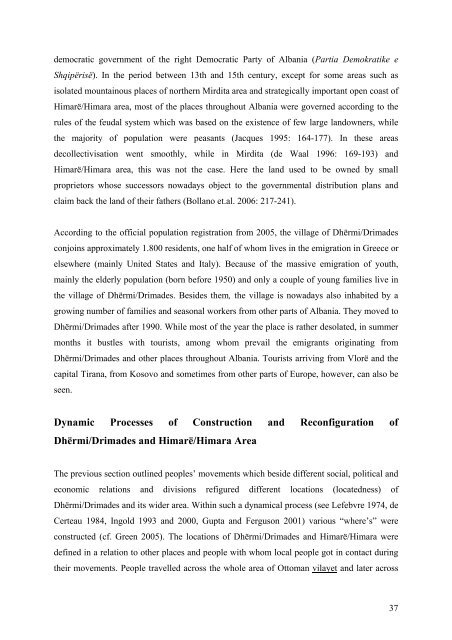university of nova gorica graduate school contested spaces and ...
university of nova gorica graduate school contested spaces and ...
university of nova gorica graduate school contested spaces and ...
Create successful ePaper yourself
Turn your PDF publications into a flip-book with our unique Google optimized e-Paper software.
democratic government <strong>of</strong> the right Democratic Party <strong>of</strong> Albania (Partia Demokratike e<br />
Shqipërisë). In the period between 13th <strong>and</strong> 15th century, except for some areas such as<br />
isolated mountainous places <strong>of</strong> northern Mirdita area <strong>and</strong> strategically important open coast <strong>of</strong><br />
Himarë/Himara area, most <strong>of</strong> the places throughout Albania were governed according to the<br />
rules <strong>of</strong> the feudal system which was based on the existence <strong>of</strong> few large l<strong>and</strong>owners, while<br />
the majority <strong>of</strong> population were peasants (Jacques 1995: 164-177). In these areas<br />
decollectivisation went smoothly, while in Mirdita (de Waal 1996: 169-193) <strong>and</strong><br />
Himarë/Himara area, this was not the case. Here the l<strong>and</strong> used to be owned by small<br />
proprietors whose successors nowadays object to the governmental distribution plans <strong>and</strong><br />
claim back the l<strong>and</strong> <strong>of</strong> their fathers (Bollano et.al. 2006: 217-241).<br />
According to the <strong>of</strong>ficial population registration from 2005, the village <strong>of</strong> Dhërmi/Drimades<br />
conjoins approximately 1.800 residents, one half <strong>of</strong> whom lives in the emigration in Greece or<br />
elsewhere (mainly United States <strong>and</strong> Italy). Because <strong>of</strong> the massive emigration <strong>of</strong> youth,<br />
mainly the elderly population (born before 1950) <strong>and</strong> only a couple <strong>of</strong> young families live in<br />
the village <strong>of</strong> Dhërmi/Drimades. Besides them, the village is nowadays also inhabited by a<br />
growing number <strong>of</strong> families <strong>and</strong> seasonal workers from other parts <strong>of</strong> Albania. They moved to<br />
Dhërmi/Drimades after 1990. While most <strong>of</strong> the year the place is rather desolated, in summer<br />
months it bustles with tourists, among whom prevail the emigrants originating from<br />
Dhërmi/Drimades <strong>and</strong> other places throughout Albania. Tourists arriving from Vlorë <strong>and</strong> the<br />
capital Tirana, from Kosovo <strong>and</strong> sometimes from other parts <strong>of</strong> Europe, however, can also be<br />
seen.<br />
Dynamic Processes <strong>of</strong> Construction <strong>and</strong> Reconfiguration <strong>of</strong><br />
Dhërmi/Drimades <strong>and</strong> Himarë/Himara Area<br />
The previous section outlined peoples’ movements which beside different social, political <strong>and</strong><br />
economic relations <strong>and</strong> divisions refigured different locations (locatedness) <strong>of</strong><br />
Dhërmi/Drimades <strong>and</strong> its wider area. Within such a dynamical process (see Lefebvre 1974, de<br />
Certeau 1984, Ingold 1993 <strong>and</strong> 2000, Gupta <strong>and</strong> Ferguson 2001) various “where’s” were<br />
constructed (cf. Green 2005). The locations <strong>of</strong> Dhërmi/Drimades <strong>and</strong> Himarë/Himara were<br />
defined in a relation to other places <strong>and</strong> people with whom local people got in contact during<br />
their movements. People travelled across the whole area <strong>of</strong> Ottoman vilayet <strong>and</strong> later across<br />
37

















